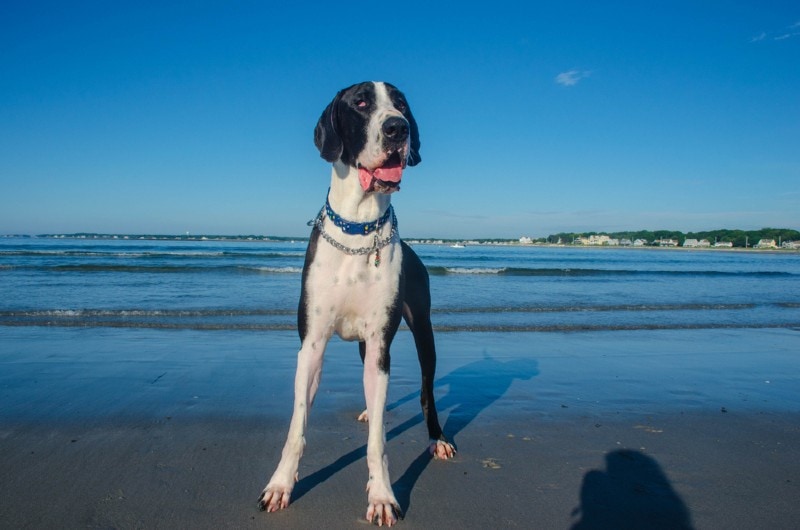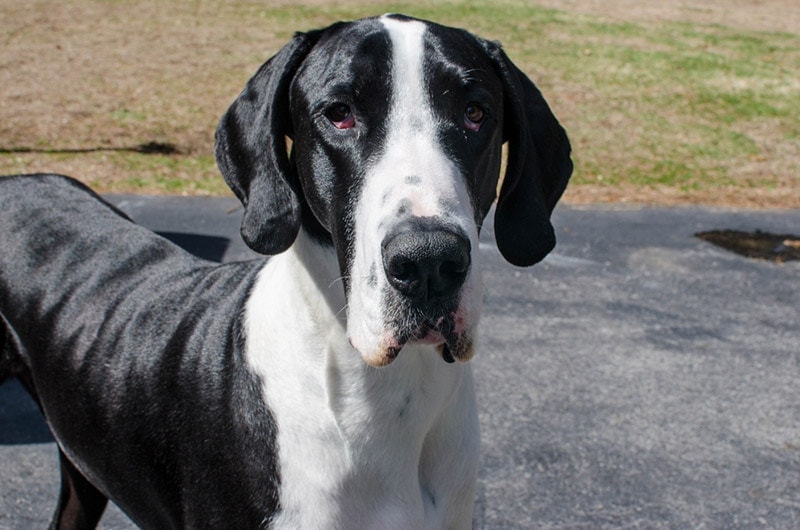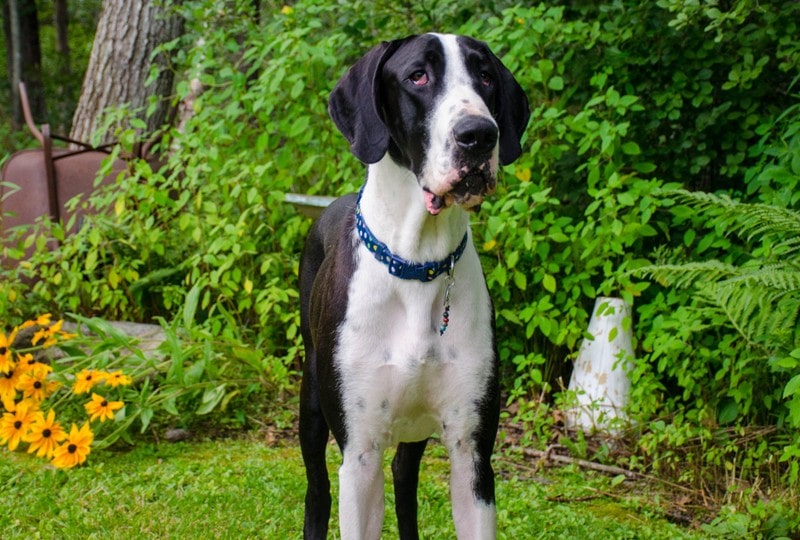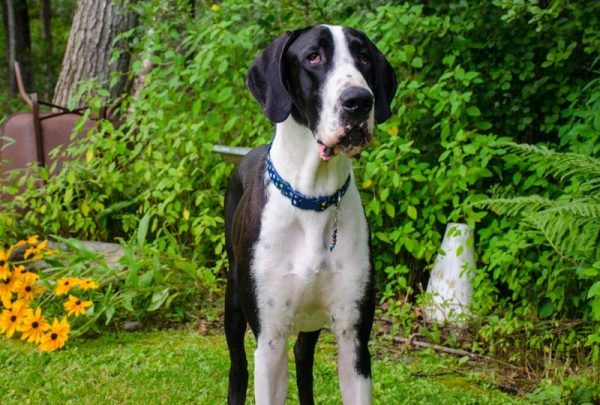Click to Skip Ahead
Mantle Great Danes represent one of the flashiest color patterns of an already hard-to-miss dog breed. Sporting a black “blanket” or mantle across their back and body, these dogs also feature splashy white markings on their face, legs, and chest. In this article, you’ll learn about the history and origins of the mantle Great Dane, along with some unique facts about the breed. We’ll also tell you what it’s like to live with this gentle giant of the dog world. Hint: prepare for drool!
Breed Overview
Height:
Male: 30 – 40 inches; Female: 28 – 32 inches
Weight:
Male: 120 – 200 pounds; female: 99 – 130 pounds
Lifespan:
7 – 10 years
Colors:
Mantle
Suitable for:
Active families with a lot of room, multiple dog households
Temperament:
Reserved, gentle, devoted, confident
Mantle Great Dane Characteristics
The Earliest Records of Mantle Great Dane in History
While we don’t know exactly when the earliest Great Dane with mantle coloring was born, the breed is among the oldest known to humans. Chinese literature from the 11th century BC talks about a dog that looks like a modern Great Dane. The original Great Danes were developed from Mastiffs, not in Denmark as their name suggests, but in Germany.
In the 16th century, Germans bred giant, fierce Great Danes to serve as boar hunters and to guard the carriages and lands of the wealthy. As Europe modernized and there was less need for Great Danes as hunters, they continued to serve as guard dogs for German royalty. During this time, Great Danes weren’t the gentle family pets they are today but unpredictable and aggressive animals.

How Mantle Great Dane Gained Popularity
In the 19th century, English and American breeders helped shape the modern Great Dane by adding Greyhound blood, leading to a more graceful, long-legged shape than the previous Mastiff type. They also improved their temperament by selecting dogs with gentler, more mellow personalities. This allowed the mantle Great Dane to move into its new role as a family pet and watchdog.
In Germany, the Great Dane was named the national dog in 1876. In this country, they also stopped using the name “Great Dane,” which is a translation of the French name for the breed and is geographically incorrect, as we already mentioned. Instead, Germans called them the “Deutsch Dogge,” or German dog, a name that sticks today.
Formal Recognition of Mantle Great Dane
The first official Great Dane club and breed standard in Germany was formed in 1881. The American Kennel Club formally recognized the Great Dane in 1887. An official breed club was formed in America in 1889 and is one of the oldest purebred dog groups in the country.
Great Danes are classified in the working group, although they primarily serve as companion dogs and family pets. You can still find them as guard dogs in Germany in some locations. Because of their large size, Great Danes are sometimes trained to serve as physical assistance dogs, supporting people with mobility problems. Well-trained and socialized Great Danes are also popular therapy dogs because of their affectionate, gentle personalities.
Top 3 Unique Facts About Mantle Great Danes
1. They’re sometimes Called “Boston Great Danes”
In the color and pattern, mantle Great Danes resemble another, much smaller breed: the Boston Terrier. Because of this, you’ll sometimes see these dogs referred to as Boston Great Danes in some countries. This nickname was pretty consistently used everywhere up until the 1990s.

2. Mantle Great Danes Sometimes Come in Other Colors.
The only formally recognized mantle color is black and white, but you’ll sometimes find them available in other colors. These dogs will have white markings like the standard mantle, but the body color will be another common Great Dane color, such as merle, fawn, or blue. Solid merle, fawn, and blue Great Danes are all allowed, but not the mantle varieties. Although you can’t show a mantle Great Dane in these off-colors, it’s still a purebred dog.
3. Mantle Great Danes Can Only Come From Specific Parents.
Mantle Great Dane puppies are only born when the parents are either mantle or harlequin Great Danes. Both parents can be mantle Great Danes or one of each color. Two harlequin parents can also produce mantle Great Danes on their own.
Does Mantle Great Dane Make a Good Pet?
Mantle Great Danes can make excellent pets, but living with a giant breed presents more challenges than others. For starters, you can expect everything to cost more for this dog, from food to crates to veterinary care. Training and socialization aren’t optional for a dog that will grow up to outweigh many humans, but the breed is generally eager to please.
Great Danes are active dogs that need daily exercise. They are social and won’t enjoy being left alone often. When socialized with kids, Great Danes can do very well with them, but they are not recommended for homes with small children because of the risk of knocking them over.
Like most giant breeds, mantle Great Danes have a relatively short lifespan. They are among the species most susceptible to bloat, a life-threatening medical emergency. Other potential health issues include hip dysplasia, bone cancer, and heart disease.
Mantle Great Danes aren’t heavy shedders, but because they’re so big, they can still produce a lot of hair. As we mentioned in the introduction, Great Danes are known for drooling.
Conclusion
Mantle Great Danes aren’t as common as some of the other breed colors, but they aren’t rare either. Choosing which color to get is less vital than determining whether you are up for the unique challenges of owning a giant breed. Once you choose to welcome a mantle Great Dane into your home, be sure to research your breeder options carefully. With several inherited medical conditions common to the breed, you want a breeder who performs all the required screenings to start you out with the healthiest puppy possible.
Featured Image Credit: mkzdillon, Shutterstock













